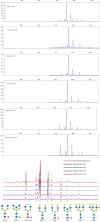Serum N-glycan markers for diagnosing liver fibrosis induced by hepatitis B virus
- PMID: 32205997
- PMCID: PMC7080998
- DOI: 10.3748/wjg.v26.i10.1067
Serum N-glycan markers for diagnosing liver fibrosis induced by hepatitis B virus
Abstract
Background: Hepatitis B virus (HBV) infection is the primary cause of hepatitis with chronic HBV infection, which may develop into liver fibrosis, cirrhosis and hepatocellular carcinoma. Detection of early-stage fibrosis related to HBV infection is of great clinical significance to block the progression of liver lesion. Direct liver biopsy is regarded as the gold standard to detect and assess fibrosis; however, this method is invasive and prone to clinical sampling error. In order to address these issues, we attempted to find more convenient and effective serum markers for detecting HBV-induced early-stage liver fibrosis.
Aim: To investigate serum N-glycan profiling related to HBV-induced liver fibrosis and verify multiparameter diagnostic models related to serum N-glycan changes.
Methods: N-glycan profiles from the sera of 432 HBV-infected patients with liver fibrosis were analyzed. Significant changed N-glycan levels (peaks) (P < 0.05) in different fibrosis stages were selected in the modeling group, and multiparameter diagnostic models were established based on changed N-glycan levels by logistic regression analysis. The receiver operating characteristic (ROC) curve analysis was performed to evaluate diagnostic efficacy of N-glycans models. These models were then compared with the aspartate aminotransferase to platelet ratio index (APRI) , fibrosis index based on the four factors (FIB-4), glutamyltranspeptidase platelet albumin index (S index), GlycoCirrho-test, and GlycoFibro-test. Furthermore, we combined multiparameter diagnostic models with alanine aminotransferase (ALT) and platelet (PLT) tests and compared their diagnostic power. In addition, the diagnostic accuracy of N-glycan models was also verified in the validation group of patients.
Results: Multiparameter diagnostic models constructed based on N-glycan peak 1, 3, 4 and 8 could distinguish between different stages of liver fibrosis. The area under ROC curves (AUROCs) of Model A and Model B were 0.890 and 0.752, respectively differentiating fibrosis F0-F1 from F2-F4, and F0-F2 from F3-F4, and surpassing other serum panels. However, AUROC (0.747) in Model C used for the diagnosis of F4 from F0-F3 was lower than AUROC (0.795) in FIB-4. In combination with ALT and PLT, the multiparameter models showed better diagnostic power (AUROC = 0.912, 0.829, 0.885, respectively) when compared with other models. In the validation group, the AUROCs of the three combined models (0.929, 0.858, and 0.867, respectively) were still satisfactory. We also applied the combined models to distinguish adjacent fibrosis stages of 432 patients (F0-F1/F2/F3/F4), and the AUROCs were 0.917, 0.720 and 0.785.
Conclusion: Multiparameter models based on serum N-glycans are effective supplementary markers to distinguish between adjacent fibrosis stages of patients caused by HBV, especially in combination with ALT and PLT.
Keywords: Chronic hepatitis B; Diagnostic power; Liver fibrosis; Multiparameter diagnostic models; N-glycan; Receiver operating characteristic curve analysis.
©The Author(s) 2020. Published by Baishideng Publishing Group Inc. All rights reserved.
Conflict of interest statement
Conflict-of-interest statement: All authors declare no conflicts-of-interest related to this article.
Figures


Similar articles
-
The gamma-glutamyl transpeptidase-to-platelet ratio predicts liver fibrosis and cirrhosis in HBeAg-positive chronic HBV infection patients with high HBV DNA and normal or mildly elevated alanine transaminase levels in China.J Viral Hepat. 2016 Nov;23(11):912-919. doi: 10.1111/jvh.12563. Epub 2016 Jul 4. J Viral Hepat. 2016. PMID: 27375134
-
Globulin-platelet model predicts minimal fibrosis and cirrhosis in chronic hepatitis B virus infected patients.World J Gastroenterol. 2012 Jun 14;18(22):2784-92. doi: 10.3748/wjg.v18.i22.2784. World J Gastroenterol. 2012. PMID: 22719186 Free PMC article.
-
Value of gamma-glutamyltranspeptidase-to-platelet ratio in diagnosis of hepatic fibrosis in patients with chronic hepatitis B.World J Gastroenterol. 2017 Nov 7;23(41):7425-7432. doi: 10.3748/wjg.v23.i41.7425. World J Gastroenterol. 2017. PMID: 29151696 Free PMC article.
-
Comparison of diagnostic accuracy of aspartate aminotransferase to platelet ratio index and fibrosis-4 index for detecting liver fibrosis in adult patients with chronic hepatitis B virus infection: a systemic review and meta-analysis.Hepatology. 2015 Jan;61(1):292-302. doi: 10.1002/hep.27382. Epub 2014 Nov 24. Hepatology. 2015. PMID: 25132233
-
Comparison of two-dimensional shear wave elastography, magnetic resonance elastography, and three serum markers for diagnosing fibrosis in patients with chronic hepatitis B: a meta-analysis.Expert Rev Gastroenterol Hepatol. 2021 Sep;15(9):1077-1089. doi: 10.1080/17474124.2021.1880894. Epub 2021 Feb 4. Expert Rev Gastroenterol Hepatol. 2021. PMID: 33487039
Cited by
-
Functional prediction of the potential NGLY1 mutations associated with rare disease CDG.Heliyon. 2024 Apr 6;10(8):e28787. doi: 10.1016/j.heliyon.2024.e28787. eCollection 2024 Apr 30. Heliyon. 2024. PMID: 38628705 Free PMC article.
-
GlycoFibroTyper: A Novel Method for the Glycan Analysis of IgG and the Development of a Biomarker Signature of Liver Fibrosis.Front Immunol. 2022 Feb 7;13:797460. doi: 10.3389/fimmu.2022.797460. eCollection 2022. Front Immunol. 2022. PMID: 35197973 Free PMC article.
-
Mass spectrometry based biomarkers for early detection of HCC using a glycoproteomic approach.Adv Cancer Res. 2023;157:23-56. doi: 10.1016/bs.acr.2022.07.005. Epub 2022 Sep 6. Adv Cancer Res. 2023. PMID: 36725111 Free PMC article. Review.
-
Serum N-glycan profiling as a diagnostic biomarker for the identification and assessment of psoriasis.J Clin Lab Anal. 2021 Apr;35(4):e23711. doi: 10.1002/jcla.23711. Epub 2021 Jan 28. J Clin Lab Anal. 2021. PMID: 33507566 Free PMC article.
-
High-Throughput Glycomic Methods.Chem Rev. 2022 Oct 26;122(20):15865-15913. doi: 10.1021/acs.chemrev.1c01031. Epub 2022 Jul 7. Chem Rev. 2022. PMID: 35797639 Free PMC article. Review.
References
-
- World Health Organization. Global hepatitis report, 2017. Available from: https://www.who.int/hepatitis/publications/global-hepatitis-report2017/en/
-
- Sharma P, Dhawan S, Bansal R, Tyagi P, Bansal N, Singla V, Kumar A, Matin A, Arora A. Usefulness of transient elastography by FibroScan for the evaluation of liver fibrosis. Indian J Gastroenterol. 2014;33:445–451. - PubMed
-
- Wai CT, Greenson JK, Fontana RJ, Kalbfleisch JD, Marrero JA, Conjeevaram HS, Lok AS. A simple noninvasive index can predict both significant fibrosis and cirrhosis in patients with chronic hepatitis C. Hepatology. 2003;38:518–526. - PubMed
Publication types
MeSH terms
Substances
LinkOut - more resources
Full Text Sources
Medical
Miscellaneous

